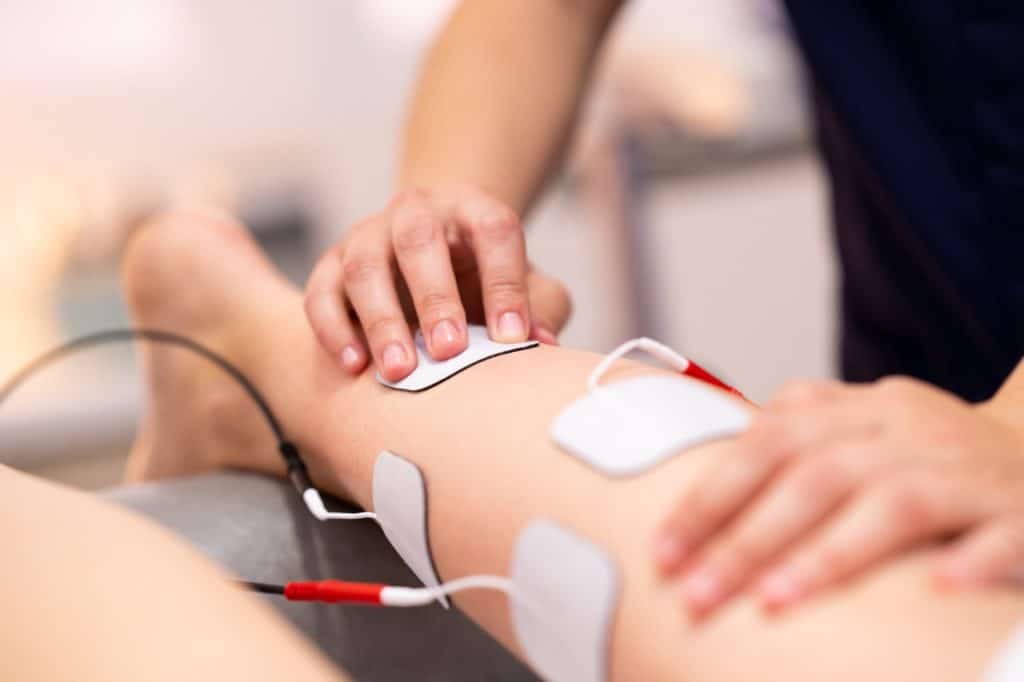Introduction to electrotherapy
Electrotherapy harnesses electrical impulses to stimulate the body’s natural healing processes, providing pain relief, offering effective pain relief, and supporting tissue repair. This non-invasive treatment can be customised in frequency, intensity, and duration to address a wide range of medical conditions. By blocking pain signals and improving blood circulation, electrotherapy helps treat pain, alleviate muscle spasms, and manage chronic pain.
Commonly utilised in physiotherapy, it is a valuable tool to treat injuries and for treating musculoskeletal injuries and disorders.
What is Electrical Muscle Stimulation (EMS)
Electrical Muscle Stimulation (EMS) is a form of electrotherapy that uses electrical currents to trigger muscle contractions. Electrical muscle stimulators are medical devices used for muscle rehabilitation and pain relief. By mimicking the natural signals from the central nervous system, an EMS device delivers electrical impulses to stimulate muscles through electrodes placed on the skin. This technology is particularly effective for strengthening or preserving muscle mass, making it valuable for individuals with physical limitations.
EMS devices are regulated for safety and are used in both clinical and athletic settings for rehabilitation, muscle strengthening, and therapy. EMS training is a method that uses electrical stimulation to enhance muscle strength and aid rehabilitation. EMS is commonly used to address conditions such as muscle weakness, atrophy, and other muscle-related issues, offering a practical solution for rehabilitation and maintenance.
EMS can complement traditional strength training by inducing involuntary muscle contractions, which mimic voluntary muscle contraction and promote neuromuscular adaptations. The EMS device works by sending electrical impulses that mimic nerve signals to activate muscles, allowing it to stimulate muscles for both rehabilitation and performance.

Electrical stimulation and its effects
Electrical stimulation is an effective method for alleviating chronic pain and reducing dependence on pain medications. By boosting blood flow to injured areas, it helps improve blood flow, which supports the healing process and helps minimise inflammation. Enhanced circulation also supports the body’s ability to heal and repair wounds more effectively. Additionally, it enhances muscle strength and function, making it a valuable tool in physical rehabilitation. This versatile treatment can address a range of conditions, including soft tissue injuries, nerve pain, chronic pain disorders, and treating medical conditions such as muscle healing and rehabilitation after injury or surgery.
Types of electrotherapy
Electrotherapy encompasses several distinct techniques, each designed to address specific therapeutic goals using different forms of electrical current. The most common types include Transcutaneous Electrical Nerve Stimulation (TENS), Electrical Muscle Stimulation (EMS), Interferential therapy, and Neuromuscular Electrical Stimulation (NMES).
- Transcutaneous Electrical Nerve Stimulation (TENS): TENS is widely used for pain relief, especially in individuals with chronic pain conditions. By delivering gentle electrical impulses through the skin, TENS helps block pain signals and provides comfort without the need for medication.
- Electrical Muscle Stimulation (EMS): EMS, also known as electrical muscle stimulation ems, targets muscle fibres to induce contractions, making it ideal for muscle strengthening, rehabilitation, and preventing muscle atrophy.
- Interferential Therapy: This method uses two high-frequency electrical currents that intersect to treat soft tissue injuries, reduce inflammation, and promote healing deep within the tissues.
- Neuromuscular Electrical Stimulation (NMES): NMES is specifically designed to improve muscle strength and function, often used in rehabilitation settings to support recovery from injury or surgery.
The choice of electrotherapy type depends on the individual’s medical condition and treatment goals. Whether the aim is to relieve pain, enhance muscle strength, or promote healing, there is a suitable electrotherapy option to meet each patient’s unique needs.
Electrotherapy devices
Modern electrotherapy devices are designed to deliver precise electrical impulses to targeted areas of the body, helping to reduce pain, improve circulation, and strengthen muscles. These devices are typically compact, portable, and user-friendly, making them suitable for both clinical and home use.
Electrotherapy devices can be programmed to provide various types of electrical currents, such as low-frequency electrical stimulation for deep tissue therapy or high-frequency stimulation for surface-level pain relief. Some devices also offer pulsed electrical stimulation, which can be tailored to individual comfort and therapeutic needs.
Certain electrotherapy devices are engineered for specific medical conditions. For example, specialised devices are available to help manage symptoms of chronic obstructive pulmonary disease (COPD) or to support joint health in knee osteoarthritis. When selecting an electrotherapy device, it is crucial to ensure it is FDA-approved and appropriate for the user’s particular health requirements.
By delivering controlled electrical currents, these devices play a vital role in reducing pain, improving mobility, and supporting overall well-being.
Physiotherapy and electrotherapy
Electrotherapy is a valuable tool in physiotherapy, widely used to complement exercise and support recovery. It is effective in treating various conditions, including musculoskeletal injuries, chronic pain, and nerve damage.
By incorporating electrotherapy, physiotherapists help patients progress toward their rehabilitation goals, which often include restoring physical activity and enhancing overall physical function.
For the best outcomes, electrotherapy is often combined with other treatments, such as targeted physical exercise, structured physical training programs, and manual therapy, creating a comprehensive approach to healing and recovery.
Electrotherapy treatment for nerve pain
Electrotherapy is an effective method for managing nerve pain, working by blocking pain signals and reducing inflammation. One widely used form of electrotherapy is Transcutaneous Electrical Nerve Stimulation (TENS), which involves small devices that deliver targeted electrical pulses to the affected area. This process helps alleviate pain and discomfort while promoting relief.
A randomised controlled trial has demonstrated that electrotherapy can significantly reduce nerve pain and improve patient outcomes, supporting its use in clinical practice.
Electrotherapy is versatile, making it a valuable treatment option for various nerve-related conditions, including chronic pain, neuropathy, and nerve damage.
How electrotherapy helps with muscle atrophy
Electrotherapy is an effective method for preventing muscle atrophy by stimulating muscle contractions and enhancing blood flow. Electrical Muscle Stimulation (EMS) delivers targeted electrical impulses to affected muscles, aiding in their recovery and improving strength and function. Studies on EMS for muscle atrophy often involve healthy subjects to assess its effectiveness and safety. While EMS is sometimes marketed for weight loss or weight reduction, its primary benefit is muscle strengthening rather than significant fat loss. This makes EMS a valuable tool in combating muscle atrophy.
When combined with exercise and physical therapy, electrotherapy can accelerate muscle recovery and help prevent further atrophy, offering a well-rounded approach to rehabilitation.
Increasing circulation
One of the key benefits of electrotherapy is its ability to increase blood flow and enhance circulation throughout the body. Improved circulation is essential for delivering oxygen and nutrients to tissues, which supports the healing process and helps reduce inflammation.
Electrotherapy devices can be used to stimulate blood flow, particularly in areas where circulation may be compromised, such as the legs and feet. This increased blood flow not only helps to promote healing in soft tissue injuries but also provides relief from chronic pain conditions by reducing muscle spasms and cramps.
Regular use of electrotherapy can help manage symptoms of conditions like restless leg syndrome and may even lower the risk of complications such as deep vein thrombosis. By supporting healthy circulation, electrotherapy contributes to faster recovery and improved overall tissue health.

Combining electrotherapy with other treatments
For optimal results, electrotherapy is often combined with other therapeutic approaches, such as physiotherapy, exercise programs, and medication. This integrated strategy can enhance pain relief, improve muscle strength, and accelerate recovery, especially in individuals with muscle weakness or chronic conditions.
Pairing electrotherapy with dynamic weight training or targeted exercise programs can help build muscle strength and fight atrophy, making it particularly beneficial for those recovering from injury or experiencing muscle wasting. Additionally, using electrotherapy alongside pain relief medication may reduce the need for higher doses, minimising potential side effects.
Regular communication with a healthcare provider ensures that electrotherapy is used safely and effectively as part of a comprehensive treatment plan. By working together, patients and clinicians can tailor therapy to achieve the best possible outcomes.
Benefits of electrotherapy
Electrotherapy is an effective treatment option for managing pain and reducing inflammation, making it particularly beneficial for chronic pain and musculoskeletal injuries. A systematic review of clinical trials supports the effectiveness of electrotherapy for certain conditions, providing evidence-based conclusions on its benefits. It aids in strengthening muscles and enhancing functionality, serving as a valuable tool in physical rehabilitation. By increasing blood flow to injured areas, electrotherapy supports the healing process and helps shorten recovery time. However, further research is needed to fully understand the long-term benefits and optimal protocols for electrotherapy in various patient populations.
This versatile treatment can address a variety of conditions, including nerve pain, muscle weakness, and chronic pain disorders.
Electrotherapy in sports medicine
Electrotherapy is a widely utilised technique in sports medicine, known for its effectiveness in treating injuries and supporting recovery. It addresses various conditions, such as muscle strains, tendonitis, and ligament sprains.
Electrotherapy, particularly EMS, has also been used by elite athletes to enhance strength and speed up recovery as part of high-performance sports training. By enhancing muscle strength and function, electrotherapy becomes an invaluable tool for athletes. Often combined with other therapies like exercise and physical rehabilitation, it not only accelerates recovery but also helps prevent future injuries.
Electrotherapy at Waverley Clinic in Farnham
At Waverley Clinic, our skilled physiotherapist, James Leyland, specialises in using electrotherapy to effectively treat sports injuries. With expertise in the latest techniques and state-of-the-art equipment, James is dedicated to delivering exceptional care and achieving the best possible outcomes for our patients.
Electrotherapy is a non-invasive and painless procedure that involves the use of electrical impulses to stimulate nerves and muscles. It can be used to target specific areas of the body or as a whole-body treatment.
James uses electrotherapy to help reduce pain, improve muscle strength and flexibility, and promote tissue healing. This treatment can also be beneficial for conditions such as arthritis, fibromyalgia, and neurological disorders.

At Waverley Clinic in Farnham, Surrey, we offer a variety of electrotherapy treatments, including ultrasound therapy and transcutaneous electrical nerve stimulation (TENS). We can assess and treat various muscle groups, including abdominal muscles, using advanced imaging and electrotherapy techniques. Shockwave therapy is also available at our clinic as a non-invasive treatment for musculoskeletal conditions such as plantar fasciitis, tendinitis, and sports injuries. These treatments are tailored to each patient’s individual needs, ensuring the most effective results.
In addition to electrotherapy, we also incorporate manual techniques such as massage and stretching exercises into our treatment plans. Our goal is to not only provide relief from pain but also to address the underlying cause of the issue to prevent future occurrences.
So what are you waiting for? If you are experiencing pain, don’t suffer in silence.
Schedule your Electrotherapy appointment with James
Booking an appointment has never been easier!
- Online Booking with James: Book Online
- By Phone: Call the Waverley Clinic at 01252 716611.
Our phone lines are open 24/7, offering a convenient seven-day telephone booking service
Let us help you get back on your feet and live a pain-free life.

